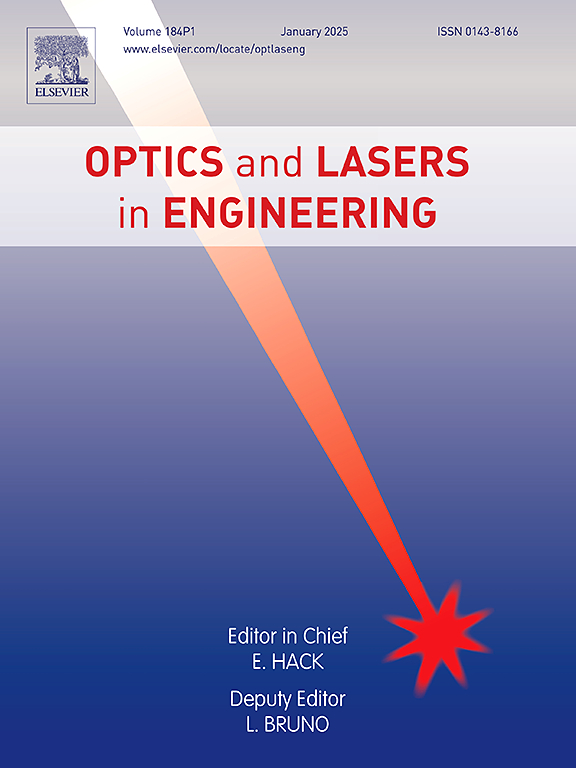Research on freeform surface detection by high precision normal measurement method based on laser confocal fixed-focus
IF 3.5
2区 工程技术
Q2 OPTICS
引用次数: 0
Abstract
To address the issue of freeform surface profile scanning measurement relying on high-precision linear motion datum, this paper proposes a high-precision normal vector measurement method based on laser confocal fixed-focus (NVM-LCFF) for freeform surface detection. This method utilizes the precise correspondence between the peak position of laser confocal axial response and objective lens focus. Through axial scanning, it simultaneously acquires both the laser confocal axial response and the spot centroid position detected by the position-sensitive detector (PSD). Capitalizing on the spot centroid measurement accuracy at the focus is the highest, this method acquires spot centroid at the focus by computationally the focus position of the laser confocal axial response, and effectively eliminates defocus-induced errors in centroid positioning. By leveraging the rotation-translation invariance of distances between sampling points and angles between normal vectors of sampling points. This method performs pre-registration by pre-scanning the coordinates and normal vectors of at least 4 sampling points. Through nonlinear least-squares optimization, an initial estimation of the position of freeform surface is obtained, thereby substantially reducing the precision requirements of position adjustment. Initial experimental verification demonstrates that this approach achieves freeform surface measurement with accuracy better than ±50 nm, effectively reducing the influence of straightness errors on measurement accuracy, and eliminating the dependence on the ultra-precise height measurement references in traditional freeform surface metrology.
基于激光共聚焦定焦的高精度法向测量法检测自由曲面研究
针对自由曲面轮廓扫描测量依赖高精度直线运动基准的问题,提出了一种基于激光共聚焦定焦(NVM-LCFF)的高精度法向量测量方法,用于自由曲面检测。该方法利用了激光共焦轴向响应峰值位置与物镜焦距之间的精确对应关系。通过轴向扫描,同时获得激光共焦轴向响应和位置敏感探测器(PSD)检测到的光斑质心位置。该方法利用焦点处光斑质心测量精度最高的特点,通过计算激光共焦轴向响应的焦点位置来获取焦点处光斑质心,有效地消除了离焦引起的质心定位误差。通过利用采样点之间的距离和采样点法向量之间的角度的旋转平移不变性。该方法通过对至少4个采样点的坐标和法向量进行预扫描来进行预配准。通过非线性最小二乘优化,获得自由曲面位置的初始估计,从而大大降低了位置调整的精度要求。初步实验验证表明,该方法实现了精度优于±50 nm的自由曲面测量,有效降低了直线度误差对测量精度的影响,消除了传统自由曲面测量对超精密高度测量参考的依赖。
本文章由计算机程序翻译,如有差异,请以英文原文为准。
求助全文
约1分钟内获得全文
求助全文
来源期刊

Optics and Lasers in Engineering
工程技术-光学
CiteScore
8.90
自引率
8.70%
发文量
384
审稿时长
42 days
期刊介绍:
Optics and Lasers in Engineering aims at providing an international forum for the interchange of information on the development of optical techniques and laser technology in engineering. Emphasis is placed on contributions targeted at the practical use of methods and devices, the development and enhancement of solutions and new theoretical concepts for experimental methods.
Optics and Lasers in Engineering reflects the main areas in which optical methods are being used and developed for an engineering environment. Manuscripts should offer clear evidence of novelty and significance. Papers focusing on parameter optimization or computational issues are not suitable. Similarly, papers focussed on an application rather than the optical method fall outside the journal''s scope. The scope of the journal is defined to include the following:
-Optical Metrology-
Optical Methods for 3D visualization and virtual engineering-
Optical Techniques for Microsystems-
Imaging, Microscopy and Adaptive Optics-
Computational Imaging-
Laser methods in manufacturing-
Integrated optical and photonic sensors-
Optics and Photonics in Life Science-
Hyperspectral and spectroscopic methods-
Infrared and Terahertz techniques
 求助内容:
求助内容: 应助结果提醒方式:
应助结果提醒方式:


